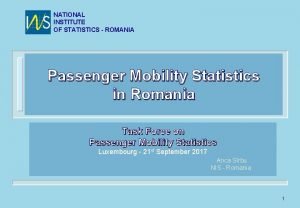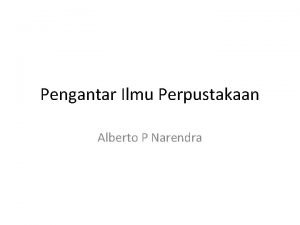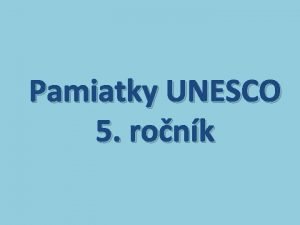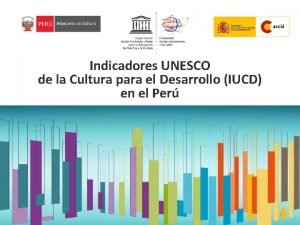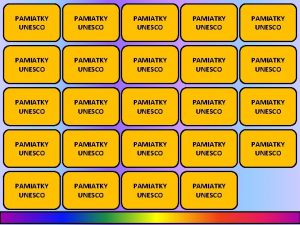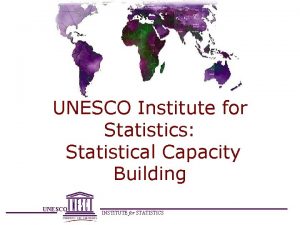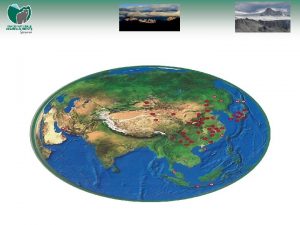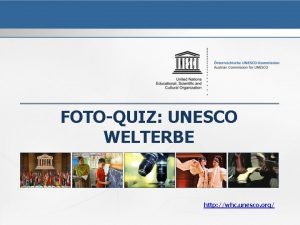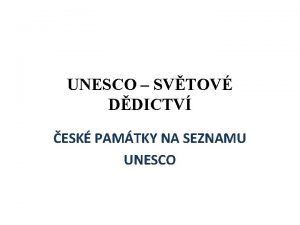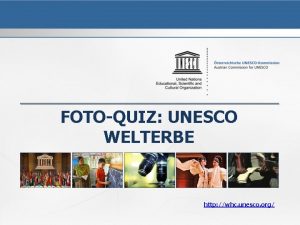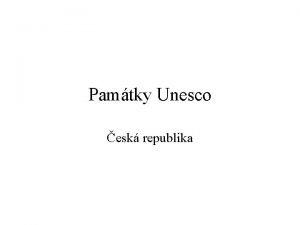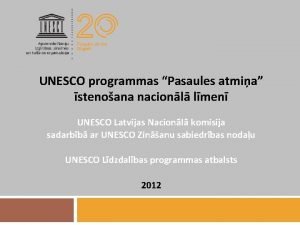UNESCO Institute for Statistics Role of Data Collection




















- Slides: 20

UNESCO Institute for Statistics Role of Data Collection, Analysis and Statistics Hendrik van der Pol Director

UNESCO Institute for Statistics Overview p Introduction to international education statistics n Why statistics, areas of statistics n Role of the UIS, principles and methods p Examples of international education statistics by the UIS n Secondary education 2

UNESCO Institute for Statistics Why statistics? p Advocacy resources in order to mobilise support and p Monitoring e. g. performance indicators, EFA observatory p Developing, informing and amending appropriate policies, ensuring decisions are evidence-based 3

UNESCO Institute for Statistics Why international statistics? Comparative data: p allows countries to learn from one another and to benchmark p provides the global picture p is used for international accountability p offers external view on your system 4

UNESCO Institute for Statistics p p p Founded in 1999 in Paris, France Relocated to Montreal, Canada in 2001 Located on the campus of Université de Montréal Has grown from 8 to 110 employees Mandated to maintain international databases for: n n Education Science and technology Culture Communication and Information 5

UNESCO Institute for Statistics UIS mandate p Collection and dissemination of cross-nationally comparable data p Analysis of comparative data p Development of international classifications p Technical capacity building within countries p Advocacy for statistics in relation to UNESCO’s areas of interest 6

UNESCO Institute for Statistics Domains of education statistics p Administrative data and planning (UIS) n p Enrolment, Graduation, Teacher, Expenditure Student assessment & surveys Testing: Achievement (mathematics, reading), classroom processes, enabling conditions n Household surveys: family background n p Literacy & Educational attainment (UIS) n Census data, household survey data 7

UNESCO Institute for Statistics UIS education survey data p Advantages for the countries: n Regular and timely monitoring of education systems n Cost efficient, capacity exists at Mo. E and NSO n Linked to education planning, consistent with information used by Mo. E n Macro-level information only n Definitions and standards set by international framework n Country appears in EFA and MDG publications 8

9 UNESCO Institute for Statistics

Human Development Index UNESCO Institute for Statistics Gender Inequality Index Education for All Knowledge Index Knowledge Economy Index ICT Development Index Global Gender Gap Global Innovation Index 10

UNESCO Institute for Statistics Examples p Participation and completion of secondary education p Expenditure on education 11

UNESCO Institute for Statistics To what extent is participation in secondary education associated with national wealth? 12

What proportion of students complete lower secondary education? UNESCO Institute for Statistics Gross graduation ratios for lower secondary education, all programmes, 2009 13

Exploring disparities in educational attainment of rural youth UNESCO Institute for Statistics Percentage of 15 to 24 year olds with less than Lower secondary (ISCED 2), by gender, in rural areas o Household survey data reveals extent of gender gaps in rural areas: n Female disadvantage n Gender parity n Male disadvantage 14 Source: Household survey data analysis. Pg. 280 -1, GMR 2012, UIS (2012 a).

Poor, urban youth face disadvantages in completing lower secondary UNESCO Institute for Statistics Percentage of 15 to 24 year olds with less than lower secondary (ISCED 2), by location and household wealth o Household survey data reveals education disparities : n Within urban areas: gap between in rich and poor urban youth n Within poorest households: gap between urban and rural youth 15 Source: Household survey data analysis. Pg. 259, GMR 2012, UIS (2012 a).

How has the gap between lower and upper secondary participation changed? UNESCO Institute for Statistics Gross enrolment ratios for lower and upper secondary education by region 16

What proportion of the population completes upper secondary? UNESCO Institute for Statistics Gross graduation ratios for upper secondary education by programme type, 2009 17

UNESCO Institute for Statistics How do governments allocate spending on education? 18

UNESCO Institute for Statistics Policy implications p Specific interventions aimed at improving the demand supply of secondary education needed in sub-Saharan Africa. p Interventions designed to improve access to upper secondary education in almost all regions should also address the content of these programmes to meet demands of the labour market. 19

UNESCO Institute for Statistics Thank you www. uis. unesco. org UIS: Data to make a difference 20
 Unesco institute for statistics
Unesco institute for statistics How to calculate gross enrollment rate
How to calculate gross enrollment rate Landsat collection 1 vs collection 2
Landsat collection 1 vs collection 2 Documentary payment
Documentary payment Data collection procedures
Data collection procedures The terms external secondary data and syndicated
The terms external secondary data and syndicated National institute of statistics romania
National institute of statistics romania Introduction to statistics what is statistics
Introduction to statistics what is statistics Role of nurse in specimen collection slideshare
Role of nurse in specimen collection slideshare Role of nurse in specimen collection slideshare
Role of nurse in specimen collection slideshare Azure web role vs worker role
Azure web role vs worker role Krappmann symbolischer interaktionismus
Krappmann symbolischer interaktionismus Role conflict occurs when fulfilling the role expectations
Role conflict occurs when fulfilling the role expectations Unesco stands for
Unesco stands for Unesco volunteer
Unesco volunteer Pengertian buku menurut unesco
Pengertian buku menurut unesco Ayersova skala vek
Ayersova skala vek Pamiatky unesco v amerike
Pamiatky unesco v amerike Unesco mappa concettuale
Unesco mappa concettuale Indicadores unesco de cultura para el desarrollo
Indicadores unesco de cultura para el desarrollo Four pillars of education b.ed notes
Four pillars of education b.ed notes






